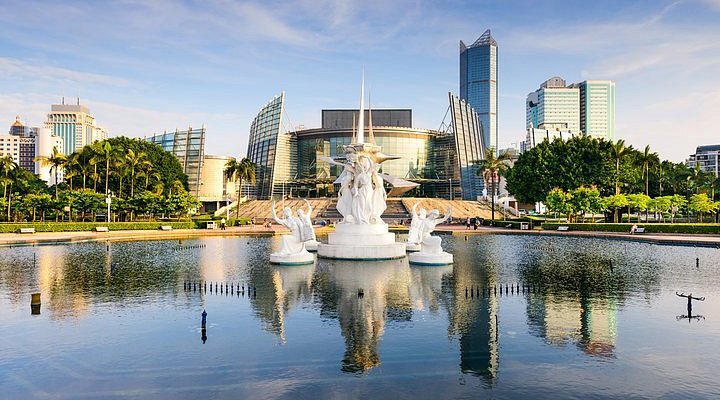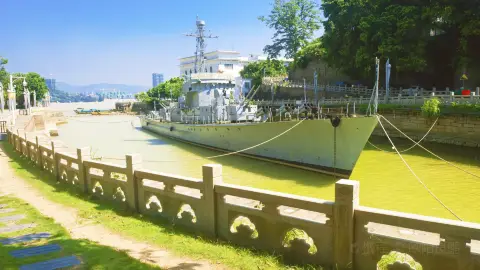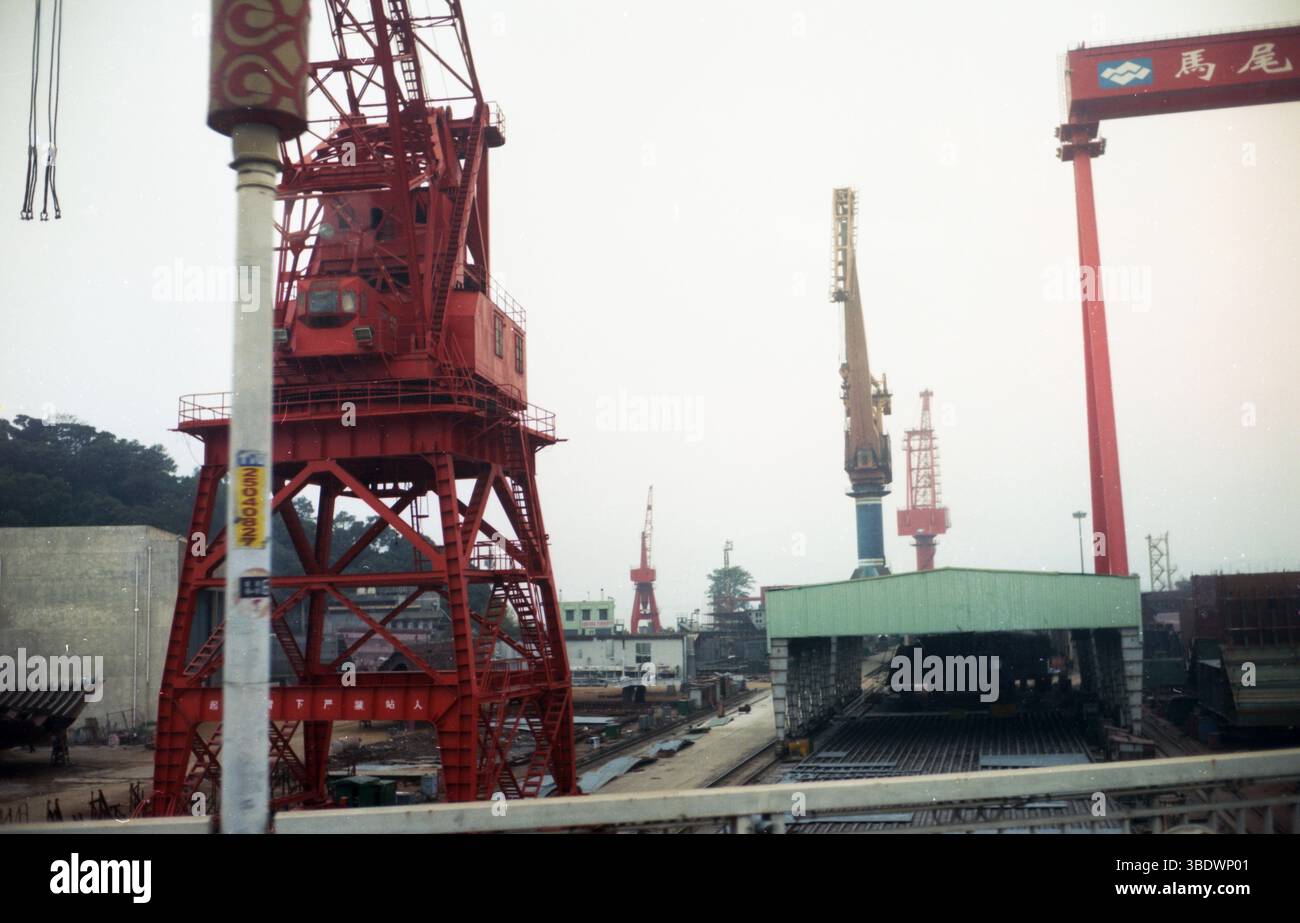A Traveler’s Guide to Mawei Shipyard: History, Culture, and Adventure

An Essential Guide to Visiting Mawei Shipyard
Nestled in the vibrant city of Fuzhou, the Mawei Shipyard stands as a remarkable testament to China’s rich maritime heritage and industrial evolution. Established in 1866 by prominent figures Li Hongzhang and Zuo Zhongtang, this historic site is not just a shipyard; it’s a living museum of naval engineering that has played a pivotal role in shaping the country’s contemporary navy and shipbuilding prowess. As you stroll through the expansive grounds, you’ll be greeted by towering cranes, sleek vessels in various stages of construction, and the echo of history that whispers tales of innovation and resilience.
Visiting Mawei Shipyard is an opportunity for travelers to delve deep into the intricate processes of shipbuilding, from the initial design phases to the final touches that bring each vessel to life. Knowledgeable guides are on hand to share insights into the shipyard’s storied past and the technological advancements that have propelled it into the modern era. The juxtaposition of industrial activity with historical relics, such as cannons and monuments, creates a captivating atmosphere that reflects both the shipyard’s operational focus and its historical significance.
Whether you are an engineering enthusiast, a history buff, or simply curious about the maritime industry, a trip to Mawei Shipyard promises to be an enlightening and visually stunning experience. As you explore this unique destination, prepare to be inspired by China’s commitment to maritime innovation and its impressive journey through time.
In This Guide
- An Essential Guide to Visiting Mawei Shipyard
- The Rich History and Legends of Mawei Shipyard
- Main Highlights: What You Absolutely Can’t Miss
- Planning Your Visit: A Practical Guide
- Tickets: Prices, Booking, and Tips
- How to Get There: A Complete Transportation Guide
- Local Cuisine and Accommodation Nearby
- Frequently Asked Questions
- Final Thoughts on Your Trip
The Rich History and Legends of Mawei Shipyard
Nestled along the scenic banks of the Min River in Fuzhou, Mawei Shipyard is a remarkable testament to China’s rich maritime heritage and industrial evolution. Established in 1866 by two prominent figures, Li Hongzhang and Zuo Zhongtang, the shipyard initially bore the name Fujian Shipyard. It quickly grew to become a cornerstone of China’s naval power, playing a pivotal role in the country’s shipbuilding endeavors.
The shipyard’s inception was a strategic response to the challenges posed by foreign naval powers during the late Qing Dynasty. Recognizing the need for modernization, Li Hongzhang and Zuo Zhongtang aimed to create an indigenous shipbuilding facility that could not only construct warships but also foster a sense of national pride. Mawei Shipyard thus became the birthplace of China’s contemporary navy, earning its reputation as the “pioneer” of military ship production in the region.
Visitors to the shipyard today are greeted by a landscape dominated by towering cranes and busy construction bays, where a myriad of vessels are crafted—from massive cargo ships to advanced naval crafts. The sight of these formidable structures is a stark reminder of the shipyard’s historical significance and its ongoing contribution to maritime engineering.
Yet, the legacy of Mawei Shipyard extends beyond mere industrial prowess. The grounds still hold echoes of the past, where remnants of cannons and cultural monuments whisper tales of a bygone era. These artifacts not only reflect the shipyard’s military history but also its role in the broader narrative of China’s struggle for sovereignty and modernization.
Guided tours offer an immersive experience, allowing visitors to delve into the intricate processes of ship construction, from initial design concepts to the final touches. Knowledgeable staff are eager to share insights into the technological advancements that have shaped the shipyard over the years, making it a captivating journey through both history and innovation.
As you explore the Mawei Shipyard, you’ll find that it is not merely a functioning industrial site; it is a living museum that encapsulates the spirit of resilience, ingenuity, and ambition that defines China’s maritime journey. Whether you are an engineering enthusiast, a history buff, or simply a curious traveler, Mawei Shipyard promises a rich tapestry of stories and experiences that will linger long after your visit.

Mawei Shipyard.
Main Highlights: What You Absolutely Can’t Miss
Visiting Mawei Shipyard offers a unique opportunity to explore a pivotal piece of China’s maritime history and industrial innovation. Here are the key highlights that travelers simply cannot miss during their visit:
Historical Significance
Founded in 1866 by notable figures Li Hongzhang and Zuo Zhongtang, Mawei Shipyard, also known as Fujian Shipyard, is the birthplace of modern Chinese naval engineering. This historical shipyard played a crucial role in establishing China’s military ship production base and remains a cornerstone of the country’s contemporary navy. Make sure to take in the rich history that surrounds this site, as it serves as a testament to China’s maritime evolution.
Guided Tours
The guided tours available at Mawei Shipyard provide an in-depth look into the shipbuilding process, from initial designs to the final product. Knowledgeable staff are eager to share insights about the technological advancements and historical events that shaped the shipyard. These tours not only educate but also engage visitors with the intricate world of naval engineering.
The Spectacle of Shipbuilding
Prepare to be captivated by the sheer scale of operations at Mawei Shipyard. The sight of towering cranes, massive vessels being constructed, and a flurry of activity is nothing short of breathtaking. Whether you’re an engineering enthusiast or simply curious, the dynamic environment showcases China’s commitment to maritime innovation.
Industrial Aesthetics
While the industrial nature of the shipyard may seem overwhelming at times, its cleanliness and organization are commendable. The sight of steel plates, screws, and high-tech machinery juxtaposed with historical relics, such as cannons and monuments, creates a visually striking contrast that reflects both the past and present of naval engineering.
Cultural Relics
Don’t overlook the cultural relics scattered throughout the yard, which tell stories of secrecy and the shipyard’s rich heritage. These artifacts serve as reminders of the shipyard’s historical significance and its role in shaping China’s maritime identity.
Convenient Access
Located at No. 139, Jiangbindongdadao in Fuzhou, Mawei Shipyard is easily accessible via public transport. Numerous bus routes, including 37, 58, and 140, will take you right to “Mawei Shipyard Station.” From there, it’s just a short walk to the entrance, making it a hassle-free visit.
Opening Hours and Admission
Mawei Shipyard welcomes visitors from 8:00 AM to 5:00 PM, and the entry fee is just 15 Yuan. This small investment grants you access to an extraordinary glimpse into one of China’s most significant industrial sites.
In summary, a trip to Mawei Shipyard is a must for anyone interested in history, engineering, and the maritime industry. Its blend of historical significance, modern technology, and cultural heritage provides an educational and visually stunning experience that is sure to enrich your travels in China.

Mawei Shipyard.
Planning Your Visit: A Practical Guide
When planning your visit to the Mawei Shipyard in Fuzhou, you’re in for a fascinating journey into the heart of China’s maritime history and industrial innovation. Here’s everything you need to know to make the most of your experience at this historical site.
Getting There
Location:
Mawei Shipyard is situated at No. 139, Jiangbindongdadao, in the Mawei District of Fuzhou. This historic shipyard is easily accessible by public transport.
Public Transport:
You can take several bus routes, including 37, 58, 139, 140, and 178. Alternatively, there is a sightseeing route connecting Three Lanes and Seven Alleys to the Mawei Shipbuilding Culture. Once you get off at “Mawei Shipyard Station,” it’s just a short 120-meter walk to the entrance.
Opening Hours
Visiting Hours:
The shipyard is open from 8:00 AM to 5:00 PM daily. Plan your visit accordingly to ensure you have ample time to explore the site.
Admission Fees
Ticket Price:
Entry to Mawei Shipyard is quite affordable, with a ticket costing just 15 Yuan. It’s a small price to pay for such an educational and visually striking experience.
What to Expect
Guided Tours:
The shipyard offers guided tours that provide insights into the intricate processes involved in shipbuilding. You’ll learn about everything from initial design to final construction. The knowledgeable staff is eager to share the rich history and technological advancements of the shipyard, making this an excellent opportunity for enthusiasts of engineering and naval history.
Visual Experience:
The sprawling facility features towering cranes and a variety of vessels under construction, including cargo ships and advanced naval crafts. The industrial atmosphere can be overwhelming, but the cleanliness and order of the yard are commendable. Be prepared to take in the impressive scale of operations.
Historical Significance:
Founded in 1866 by notable figures Li Hongzhang and Zuo Zhongtang, Mawei Shipyard has deep historical roots, serving as a base for China’s modern navy and as a pioneer in military ship production. As you walk through the yard, keep an eye out for remnants of history, including cannons and cultural relic monuments that hint at the shipyard’s past.
Nearby Attractions
While visiting Mawei Shipyard, consider exploring nearby attractions to enrich your experience:
- Luoxing Tower: A scenic observation point offering panoramic views.
- Fuzhou Majianghaizhan Memorial Hall: A historical museum worth a visit.
- Majiang Sea Warfare Fort: Explore ancient ruins that tell the story of maritime defense.
Dining Options
After your visit, you might want to grab a bite to eat. There are several dining options nearby, including:
- Dicos (MaWei): An American fast-food chain for a quick meal.
- Ka Li Da PiSa: A local pizza spot for a casual dining experience.
- Ali Lang Korean Restaurant: Offering Asian and Korean cuisine for those looking to try something different.
Tips for Your Visit
- Photography: Bring your camera! The shipyard’s impressive structures and vibrant activity make for great photos.
- Dress Comfortably: Wear comfortable shoes as you may be walking quite a bit.
- Stay Informed: Be sure to check the weather forecast before your visit, as the shipyard is mostly outdoors.
With this guide in hand, you’re well-equipped to delve into the fascinating world of shipbuilding at Mawei Shipyard. Enjoy your visit!

Mawei Shipyard.
Tickets: Prices, Booking, and Tips
Visiting the Mawei Shipyard is a fascinating experience that offers a glimpse into China’s maritime heritage and industrial innovation. Here’s everything you need to know about tickets, prices, and tips for planning your visit.
Ticket Information
- Price: The entrance fee to Mawei Shipyard is a modest 15 Yuan (approximately $2.30 USD), making it an affordable destination for travelers.
- Opening Hours: The shipyard is open daily from 8:00 AM to 5:00 PM. It’s advisable to arrive early to fully explore the grounds and possibly catch a guided tour.
Booking Tips
- Advance Booking: While tickets can typically be purchased at the entrance, it’s a good idea to check if online booking options are available closer to your visit date, especially during peak tourist seasons.
- Guided Tours: Consider joining a guided tour for a richer experience. Guides are knowledgeable and can provide insights into the history and technological advancements of the shipyard, enhancing your understanding of the site.
Getting There
- Public Transportation: The shipyard is accessible via several bus routes, including 37, 58, 139, 140, and 178. Alternatively, take the sightseeing route from the Three Lanes and Seven Alleys to Mawei Shipbuilding Culture. Disembark at “Mawei Shipyard Station” and walk about 120 meters to reach the entrance.
Additional Tips
- Dress Comfortably: Given the industrial environment, wear comfortable clothing and closed-toe shoes. It may also be wise to bring a hat or sunscreen if you’re visiting on a sunny day.
- Camera Ready: The shipyard’s impressive scale and operations provide numerous photo opportunities, so don’t forget your camera!
- Nearby Attractions: After your visit, explore nearby attractions such as the Majiang Sea Warfare Fort or the Zhenghe Maritime Museum to further enrich your understanding of Fuzhou’s maritime history.
With a bit of planning, your visit to Mawei Shipyard can be an enlightening and memorable part of your journey in Fuzhou!
How to Get There: A Complete Transportation Guide
Reaching the historic Mawei Shipyard (马尾船政遗址) in Fuzhou is a straightforward endeavor, thanks to the efficient public transportation options available in the area. This guide will provide you with the necessary information to navigate your way to this fascinating site with ease.
Location
Mawei Shipyard is located at No. 139, Jiangbindongdadao, in the Mawei District of Fuzhou. The shipyard is a significant landmark, reflecting the rich maritime history and industrial innovation of China.
Getting There by Public Transport
By Bus
One of the most convenient ways to reach the Mawei Shipyard is by taking the bus. Multiple routes service the area, making it accessible from various parts of Fuzhou. Here are the bus routes you can take:
- Bus Routes: 37, 58, 139, 140, and 178
- Sightseeing Route: This route connects the popular Three Lanes and Seven Alleys with the Mawei Shipbuilding Culture area.
Stop Name: Alight at Mawei Shipyard Station. From there, it is a short walk of approximately 120 meters to the entrance of the shipyard.
By Taxi or Ride-Sharing
If you prefer a more direct route, taxis and ride-sharing services like Didi are widely available throughout Fuzhou. Simply provide the driver with the destination address (No. 139, Jiangbindongdadao), and you will be taken directly to the shipyard. This option is particularly useful if you are traveling with a group or carrying heavy luggage.
Opening Hours and Admission
The Mawei Shipyard is open daily from 8:00 AM to 5:00 PM. Admission is quite affordable, with tickets priced at 15 Yuan. It’s advisable to check for any potential changes in hours or ticket prices before your visit.
Additional Tips
- Plan Your Visit: Guided tours are available and can enrich your experience by providing insights into the shipyard’s history and the shipbuilding process.
- Be Prepared for Industrial Surroundings: The shipyard has an industrial atmosphere, complete with towering cranes and ongoing construction. Wear comfortable clothing and footwear suitable for walking.
- Nearby Attractions: If time permits, consider visiting nearby attractions such as the Zhenghe Maritime Museum or taking a stroll through scenic parks in the vicinity.
With this guide in hand, you are well-equipped to make your way to the Mawei Shipyard, where you can immerse yourself in China’s maritime heritage and witness the impressive scale of modern shipbuilding. Enjoy your visit!

Mawei Shipyard.
Local Cuisine and Accommodation Nearby
When you visit the Mawei Shipyard, not only will you be immersed in the rich maritime history of Fuzhou, but you will also discover a delightful culinary scene and comfortable accommodations nearby that enhance your travel experience.
Culinary Delights
Just a short stroll from the shipyard, you’ll find a variety of dining options that reflect the local flavors of Fujian cuisine, known for its emphasis on fresh seafood and aromatic broths. Here are a few recommended spots:
-
NianNian Da FengShou Yu Zhuang (年年大丰收渔庄)
Located approximately 0.3 miles away, this restaurant specializes in authentic Fujian seafood dishes. From their famous fish soup to stir-fried clams, each dish is a testament to the region’s culinary heritage. -
HuangHe Lou (黄河楼)
A 0.5-mile walk will lead you to this popular Chinese eatery, which offers a mix of Hunan and Szechuan specialties. Indulge in spicy hot pot or savory dumplings that capture the essence of traditional Chinese flavors. -
ALi Lang Korean Restaurant (阿里郎韩国餐厅)
If you’re in the mood for something different, this Korean restaurant is just 0.2 miles from the shipyard. Enjoy a variety of Korean BBQ options and hearty dishes that are sure to satisfy. -
MaJia Cun ShouGong MiFen (马家村手工米粉)
Close by (about 0.2 miles), this eatery is known for its hand-made rice noodles, served in rich broths or stir-fried with vegetables and meats. It’s a perfect spot for a quick and delicious meal.
Comfortable Stays
After a day of exploring the shipyard, unwind in one of the nearby accommodations that cater to international travelers:
-
Fuzhou Mawei International Hotel (福州马尾国际大酒店)
Located about 1 mile from the shipyard, this hotel offers modern amenities, comfortable rooms, and a restaurant featuring both local and international cuisines. The staff is known for their hospitality, making it a great choice for foreign visitors. -
Hanting Hotel Fuzhou Mawei (汉庭酒店福州马尾店)
A budget-friendly option just a short distance from the shipyard, this hotel provides clean and cozy rooms equipped with essential amenities. It’s ideal for travelers looking for simple, comfortable accommodations without breaking the bank. -
Pullman Fuzhou Tahoe (福州泰禾铂尔曼酒店)
For a more upscale experience, consider the Pullman Fuzhou Tahoe, which is approximately 5 miles from Mawei Shipyard. This hotel features luxurious rooms, a spa, and several dining options, making it perfect for those looking to indulge during their stay.
With a variety of local dishes to savor and comfortable accommodations to rest your head, your visit to Mawei Shipyard promises to be both enjoyable and enriching. Be sure to take your time exploring the flavors of Fujian and the welcoming hospitality of Fuzhou!

Mawei Shipyard.
Frequently Asked Questions
-
What are the opening hours of Mawei Shipyard?
Mawei Shipyard is open daily from 8:00 AM to 5:00 PM. It’s advisable to plan your visit within these hours to fully enjoy the guided tours and explore the site. -
How much does it cost to enter Mawei Shipyard?
The ticket price for entering Mawei Shipyard is 15 Yuan, making it an affordable destination for those interested in maritime history and engineering. -
How can I get to Mawei Shipyard using public transport?
You can take several bus routes to reach the shipyard, including Routes 37, 58, 139, 140, and 178. Additionally, there’s a tourist route connecting Three Lanes and Seven Alleys to Mawei Shipbuilding Culture. Disembark at “Mawei Shipyard Station” and walk approximately 120 meters to the entrance. -
Are guided tours available at Mawei Shipyard?
Yes, guided tours are offered and provide an insightful look into the shipbuilding process, the history of the yard, and its technological advancements. The staff is knowledgeable and enthusiastic about sharing information! -
Is there anything specific I should know before visiting?
While the shipyard is an industrial site, it is well-maintained and orderly. Be prepared for a fascinating yet bustling atmosphere. It’s also advisable to wear comfortable shoes as you will be walking around the extensive grounds. -
What historical significance does Mawei Shipyard hold?
Established in 1866, Mawei Shipyard, historically known as Fujian Shipyard, is a cornerstone of China’s naval history and has been a pivotal site for military ship production. It reflects the maritime prowess and industrial innovation of the country. -
Can I take photographs at the shipyard?
Yes, visitors are generally allowed to take photographs during their visit. However, be mindful of any specific signs or instructions from staff regarding areas where photography may be restricted for safety or confidentiality reasons. -
What nearby attractions or activities can I enjoy after visiting Mawei Shipyard?
After exploring the shipyard, consider visiting nearby attractions such as the Zhenghe Maritime Museum, Luoxing Tower, or the scenic Majiang Sea Warfare Fort. There are also various dining options in the vicinity to enjoy a meal after your visit!
Final Thoughts on Your Trip
As you conclude your journey through the historic Mawei Shipyard, take a moment to reflect on the unique blend of innovation, history, and culture that this iconic site embodies. Founded in 1866, the shipyard stands as a powerful testament to China’s maritime achievements and industrial evolution. The towering cranes and expansive shipbuilding facilities offer not just a glimpse into the past but also a vision of the future, where engineering marvels come to life.
Whether you’re captivated by the intricate processes of shipbuilding, intrigued by the historical significance of this naval base, or simply enjoying the stunning views along the river, your visit to Mawei Shipyard is sure to leave a lasting impression. Remember to engage with the knowledgeable staff, who are eager to share insights into this fascinating world of maritime craftsmanship.
As you leave, carry with you the spirit of exploration and innovation that defines Mawei Shipyard. This destination not only enriches your understanding of China’s naval history but also inspires a deep appreciation for the art of engineering that shapes our world today. Safe travels, and may your adventures continue to unfold!